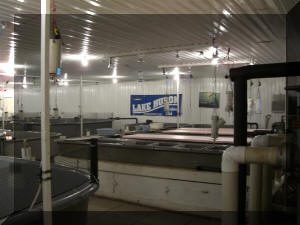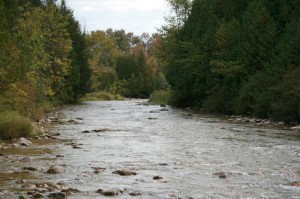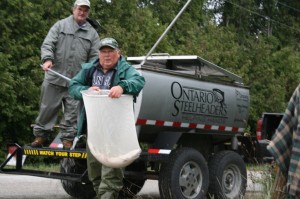I’ve known Rod Jones for more than 40 years. I also knew that when he offers up a couple of free beers it was going to cost me in the long run. This time around I just didn’t know that it was going to be a 10 year run.
It was just about a decade ago that Rod popped a couple of caps and asked if the Saugeen could really be rejuvenated. He already knew that I had proposed to the Ministry of Natural Resources, that the MNR reinstate a rainbow trout stocking program on the Saugeen. The plan at the time was pretty simple. Raise 50,000 quality yearling trout and release them in the vicinity of Walkerton for perfect imprinting. The problem was there was no money in the government coffers at the time.
Those two beers led to a couple of conversations with Kevin Hawthorne the Owen Sound district’s supervisor at the time and Kathy Dodge the district’s biologist. From there a meeting was convened with the ministry and a few members of the Ontario Steelheaders and Lake Huron Fishing Club. The ball was beginning to roll!
Rearing Rainbows and Stocking
I’ve always had a simple theory when it comes to stocking fish properly. You take the right fish, you raise the fish to the right size and you stock the fish in the right place. Today, with urban encroachment, a growing population from coast to coast, less provincial, municipal and federal funding available and growing fishing pressure, every fish raised in a hatchery is important. With that in mind, it’s important to remember, you don’t raise fish to waste fish.
I’m getting a little long in the tooth. I’ve been around raising fish for more than 40 years. That being said, in more than 40 years I’ve seen more raised and stocked and wasted than most people and there’s no reason to waste these valuable stocks. Trust me, that doesn’t happen on the Saugeen.
I’m going to take a moment to thank the efforts of Al Wilkins and his crew at the Lake Huron Fishing Club’s Kincardine Fish Hatchery. Our goal has always been to raise quality 8 inch steelhead yearling smolts and in my 65 years, I’ve never seen better looking rainbow smolt ready for stocking than those raised by Wilkins and his staff. The same can also be said for the Port Elgin hatchery where Gary Biederman and his boys raise not only additional steelhead smolts, but also the Chinook smolts that also go into the Saugeen every year.
I’ve put enough hours into raising trout and salmon over the years to know what these volunteers go through to reach their target weights and quality fish that have to reach the smolt stage before stocking. Yes, it’s fun work, but it’s also tedious work. Between babysitting, feeding and freezing these volunteers deserve your gratitude.
The Kincardine facility in particular, is one of a kind, modern, an almost state of the art facility. Every volunteer club in the province and even some provincial staffers could learn a thing or two by visiting Wilkins over at the Kincardine hatchery.
Again, these fish are ready to go when we stock each spring. They are healthy, spunky and prepared to enter the wild. I believe the boys from Kincardine have reached our 50,000 target every year since the start of the program.
Every one of our rainbow are stocked as far upriver as our permits allow. The majority are stocked out at Walkerton and a few go into a smaller tributary just north the town. Both locations are approximately 40 miles from the hatcheries and approximately 40 miles from Lake Huron. The reason that we stock them so far upriver is allow the fish to achieve maximum imprinting of the Saugeen so that the highest numbers of these yearlings will pick up the characteristics of the river and return in the greatest numbers back to the Saugeen to provide maximum fishing results and maximum spawning results.
Over the years, I’ve heard some complain that other river locations could be used for release. The thought that we put too many young fish in one or possibly two locations is rubbish. Properly raised rainbow smolt released right out of the tanker for the most part head straight for the lake. That 40 miles can be covered usually in a day or two. Yes, a few cormorants capture a few, but the word to remember is ‘few’. Some mortality can be expected no matter where you stock fish, but the two sites we utilize are essential locations for maximum imprinting and return. There are a couple of other branches of the Saugeen that have been suggested, but they are not suitable for either trout stocking or a home for returning adult fish.
By the way, when these trout return, they just don’t magically stop and spawn in the waters around Walkerton. A small majority of fish will spawn near the release sites and downstream of Walkerton, but the majority head up the main river and that’s where we want them to travel. These returning fish are proven to follow the current and move through the fishways at Walkerton and Maple Hill and then into the tributaries of the main Saugeen and the South Saugeen.
Just how great is the growth, conditioning and imprinting of this program really is, was evident that first year 6 months after the first fish were stocked. I expected the first return to show itself a year and half later after the first stocking. Instead, numerous rainbow were being caught in the lower river 6 months after being first stocked.
Again thank you to the guys from Lake Huron and especially Al Wilkins. You guys put out the finest steelhead yearlings anywhere in the country as far as I’m concerned.
The Fishways
It’s imperative that returning rainbow are allowed to make their way above Walkerton, especially into the Beatty Saugeen and other tributaries in the South Saugeen. If the main river from Maple Hill dam, downstream contained large stretches of suitable spawning and rearing water, there would be no reason to stock rainbow or transport adults. The water in this stretch is not conducive to permit adequate trout survival at hatching or their first year of holdover. Most years it freezes lock tight, it muddies and silts killing eggs and in summer it attains temperatures too high for maximum steelhead survival.
Over the last decade we’ve made major changes to the Walkerton fishway and installed a new fishway on the Maple Hill Dam.
Walkerton an old original fishway, constructed in conjunction with the Ontario Steelheaders and Dominion Founderies decades ago required a major facelift and the Ontario Steelheaders again took on the task of updating the structure. Working with the Ontario Ministry of Natural Resources, the Lake Huron Fishing Club’s Mike Hahn and Owen Sound engineer Jeff Graham massive water control panels were installed at both the top and bottom of the fishway. Believe me this was no easy task. It was almost an entire revamp. Less than an hour after the fishway was official opened and flowing, big mature trout were entering the fishway, ascending the passage way and finding their way to more suitable upstream spawning grounds.
I would especially like to thank Owen Sound Ministry of Natural Resources supervisor Shawn Carey and Jody Scheifley. These two government representatives have constantly kept the doors open, worked with the Ontario Steelheaders / Lake Huron Fishing Club and been major proponents of our stocking and fishway programs. They both were also instrumental as we worked together to construct the new second fishway on the Maple Hill power dam south of Hanover two years ago.
With the second fishway now in operation more adult steelhead can ascend the main river to Hanover, but more important enter the South Saugeen to the Beatty.
Adult Transfers
For what seems like eons, the Ontario Steelheaders have been transferring adult steelhead into the Beatty and another tributary above Walkerton. For those that don’t know the Beatty, the 40 mile stretch of river up to Highway 6 offers some of the finest spawning and rearing water for steelhead anywhere east of the Rocky Mountains.
Originally the club would transport as many as 500 steelhead each spring from their capture site at Dennys Dam to the Beatty. With the start of the new program almost a decade ago the spring total was expanded to 1,000 adult fish. We have also implemented a fall transport program that sends an additional 500 adults to the Beatty Saugeen.
I can’t emphasis enough just how important this operation is to the general betterment of Saugeen steelhead fishing in future years. The sole purpose of the transport program is to establishing a self-supporting natural reproducing steelhead fishery for the entire Saugeen system. Again, the waters below Walkerton can provide great fishing, but it is the stretches of river above Walkerton that will act as proven spawning grounds and nursery habitat. It’s imperative to establish natural spawning runs throughout the lower stretches of the Beatty all the way to Highway 6. This portion of river can produce hundreds of thousands of rainbow smolt annually in the future. The adult fish that we stock in the lower Beatty naturally make their way upstream and choose their own spawning sites.
I’ve been questioned in the past about possibly putting too many adults in the Beatty and the harm they might do to juvenile trout growing in the system. The answer is almost no harm at all. Adult steelhead wintering over in cold water seldom actually feed. Spawning fish are present to do just that….spawn and reproduce. If anything the adults provide a food source for the smaller fish when eggs fail to be covered and drift down with the current. Look at any major west coast river, pre-spawning and spawning adults co-exist with younger fish growing up in the nursery waters. Please enough from the worry warts.
Again, for this program to be completed and succeed, as many adults as possible have to spawn in the Beatty. The stretch we work on is a great system, with the potential to pump out hundreds of thousands of rainbow smolt annually. Our goal with the seasonal transportations of adults is to establish the Beatty as a major spawning site and again the moving of adults by trailer is essential in attaining that goal.
That being said, it goes without saying that Grant McAlpine and his crew working the Denny’s fishway lift deserve all the applause that can be bestowed up on them. We’ve now got three trailers on the road for ferrying the adults upriver, but it’s Grant and his boys that put the fish in those trailers.
The Near Future
If you believe that this is all the Ontario Steelheaders are involved in you are wrong. Two major projects are on the planning boards, but until approved and started for the time being we are not discussing them.
What everyone has to realize is the fact, we need more members and more volunteers. Some members of the club don’t seem to like it when I use the term ‘Old Boys Rule! Well, to me that’s tough. It is a fact. Look around at all the projects and endeavors we carry out. It is the senior element that has been carrying the ball on a lot of these labours. That’s not to say that we don’t have a growing number of younger members and those ranks are growing considerably and it is appreciated. Still, we now have thousands of anglers visiting the Saugeen. I hope they recognize the importance of joining the Ontario Steelheaders and improving this great fishery even more.
Just before closing this down, I would like to add that a couple of guys really need a big thank you for what is happening on the river. Rod Jones has spent ‘ages’ working to improve this fishery and he needs a big congrats for all his time and effort. Then there’s our president Karl Redin who works 24/7 on every aspect of the program. I don’t make one move without conferring with one or the other and usually both. When Rodney and I sat down and popped caps about a decade ago, I knew it would succeed. Succeed it has. You have the best steelhead fishery on the continent as far as I’m concerned.
It’s been a long ride, but a good ride. Let’s keep it up.





0 Comments
Add your Comment!